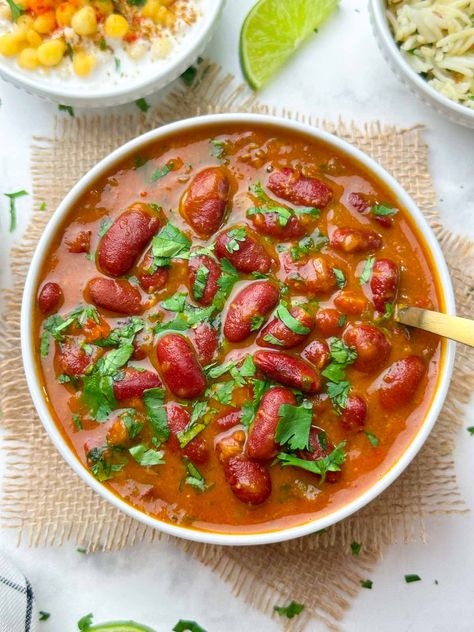
Rajma Masala is a quintessential North Indian dish that embodies comfort, flavor, and nostalgia. This hearty curry made with red kidney beans simmered in a spiced tomato-based gravy is not only a staple in Indian households but also a beloved delicacy worldwide. Its rich, creamy texture and robust flavors make it a perfect accompaniment to steamed rice, popularly referred to as “Rajma Chawal” in India. Let’s dive into the story, preparation, and the cultural significance of this beloved dish.
A Dish Rooted in Tradition
Rajma Masala’s origins can be traced back to the Indian subcontinent, but red kidney beans themselves are believed to have been introduced to India from Central America. Over time, these beans were adapted into Indian cuisine, where spices and culinary techniques elevated their humble nature into a dish that is now a culinary icon.
In Indian homes, Rajma Masala is often prepared during weekends or special occasions, filling kitchens with its tantalizing aroma. It’s a dish that’s as much about the process as it is about the end result. From soaking the beans overnight to slow-cooking the gravy, every step contributes to its irresistible taste.
Ingredients: The Building Blocks of Flavor
The magic of Rajma Masala lies in its simplicity and the harmony of its ingredients. Here’s what you’ll need:
For the Beans:
- 1 cup red kidney beans (rajma), soaked overnight
- 4 cups water
- ½ tsp turmeric powder
- ½ tsp salt
For the Masala:
- 2 tbsp oil or ghee (clarified butter)
- 1 tsp cumin seeds
- 2 large onions, finely chopped
- 3-4 garlic cloves, minced
- 1-inch piece of ginger, grated
- 2-3 green chilies, slit (adjust to taste)
- 3 medium tomatoes, pureed
- 1 tsp coriander powder
- 1 tsp cumin powder
- ½ tsp turmeric powder
- 1 tsp red chili powder (adjust to taste)
- ½ tsp garam masala
- Salt to taste
- ¼ cup fresh cream (optional, for a richer texture)
- Fresh cilantro (coriander) leaves, chopped, for garnish
Step-by-Step Preparation
1. Preparing the Beans:
- Rinse the soaked kidney beans thoroughly.
- Pressure cook them with water, turmeric, and salt until they are soft but not mushy. This usually takes about 15-20 minutes. If you’re using a stovetop pot, it might take longer.
- Reserve the cooking liquid, as it adds depth to the gravy.
2. Making the Masala:
- Heat oil or ghee in a deep pan.
- Add cumin seeds and let them sizzle.
- Stir in the onions and sauté until golden brown. This step is crucial for a flavorful base.
- Add the ginger, garlic, and green chilies. Cook until the raw aroma disappears.
- Pour in the tomato puree and cook until the oil separates from the masala.
3. Spicing it Up:
- Sprinkle coriander powder, cumin powder, turmeric, and red chili powder. Mix well and cook for 2-3 minutes.
- Add the cooked kidney beans along with the reserved liquid. Stir everything together and let it simmer for 10-15 minutes.
4. Finishing Touches:
- Stir in garam masala and fresh cream (if using).
- Adjust the salt and consistency as needed. The gravy should be thick and luscious.
- Garnish with chopped cilantro before serving.
Serving Suggestions
Rajma Masala is traditionally paired with steamed basmati rice, creating the classic “Rajma Chawal” combination. However, it’s equally delightful with buttered naan, roti, or even quinoa for a healthier twist. Add a side of pickled onions, green chilies, and a dollop of yogurt to complete the meal.
Tips for the Perfect Rajma Masala
- Choose Quality Beans: Opt for good-quality kidney beans for a better texture and taste.
- Soaking is Key: Soaking the beans overnight not only reduces cooking time but also makes them easier to digest.
- Balance the Spices: Adjust the spice levels to your preference, but don’t skimp on the garam masala—it’s the soul of the dish.
- Low and Slow: Allowing the curry to simmer enhances the flavors, making it richer and more aromatic.
Nutritional Benefits
Rajma Masala isn’t just delicious; it’s also nutritious. Kidney beans are a great source of plant-based protein, dietary fiber, and essential minerals like iron and potassium. When paired with rice, it forms a complete protein, making it an excellent choice for vegetarians and vegans.
A Global Favorite
While Rajma Masala is deeply rooted in Indian cuisine, its popularity has transcended borders. It’s a dish that brings comfort to Indian expatriates and introduces newcomers to the rich tapestry of Indian flavors. Many variations of this dish exist globally, adapted to local palates and ingredients, but the essence remains the same—a celebration of simplicity and flavor.
A Personal Touch
Every family has its unique way of making Rajma Masala. For some, it’s about adding a pinch of asafoetida (hing) for an extra layer of flavor. For others, it’s the addition of kasuri methi (dried fenugreek leaves) that makes all the difference. My mother’s recipe, for instance, includes a secret ingredient—a hint of ground fennel seeds—that gives it a slightly sweet and aromatic twist.
Why We Love Rajma Masala
Rajma Masala isn’t just a dish; it’s an emotion. It’s the warmth of home-cooked meals, the joy of sharing food with loved ones, and the comfort of familiar flavors. Whether you’re savoring it on a rainy day or serving it at a festive gathering, Rajma Masala never fails to delight.

One Response